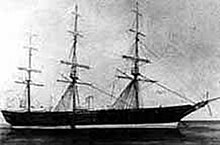Boshin war



The Boshin War ( Japanese 戊辰 戦 争 , Boshin sensō ) 1868 - 1869 was fought between the Tokugawa - bakufu and the imperial forces of Japan . The defeat of Bakufu cleared the way for a fundamental transformation of Japanese society as part of the Meiji Restoration .
background
For several years there had been disagreement between the Bakufu and the reformist Sonnō-jōi movement. On November 8, 1867, the rebellious Han Tosa , Satsuma and Chōshū had agreed on a common approach to overthrow Bakufu. The ruling Shogun Tokugawa Yoshinobu declared the return of his office the next day ( 大 政 奉還 , taisei hōkan), but did not expressly waive his participation in a new government.
In the international competition between the great powers, the Boshin War was also a test of strength between the French Empire, which openly supported the Tokugawa-Bakufu and the northern Japanese rebels still loyal to the shogunate, and the United Kingdom, which remained "neutral" by defeating the southern Japanese rebellion and the new Meiji government armed.
Thomas Glover , a Scottish trader in Nagasaki, supplied weapons to Satsuma and Chōshū and helped several Satsuma Chōshū samurai (including Itō Hirobumi , Inoue Kaoru in 1863 ) to study in England.
Armstrong cannon of the Army of Saga from the Battle of Ueno
Course of war
Events came to a head on January 3, 1868, when the Reformer Alliance, on behalf of the emperor , declared the shogunate to be completely abolished. Three weeks later, after the announcement of the suppression of the Satsuma ( 討 薩 の 表 , tōsatsu no hyō) , Tokugawa Yoshinobu set his troops in the direction of Kyōto , the seat of the Tennō. Despite a three-to-one superiority and training by French military advisers , the first major battle of Toba-Fushimi resulted in the total defeat of the shogun's 15,000-strong but poorly managed force. This forced Yoshinobu to flee to Edo by ship .
Saigō Takamori now led the victorious imperial troops without encountering any significant resistance, initially to Edo, which was reached in early April. After negotiations on April 5 and 6, which were carried out on the Tokugawa side of Katsu Kaishū with Saigō, Edo was surrendered without a fight on May 3. Katsu achieved that the Tokugawa family was confirmed in its existence, also for the future. A troop of Shogun supporters, called "Shogitai" ( 彰 義 隊 ), tried to secure the Kan'ei Temple on Ueno Hill (the shogun's alternative quarters), but was subordinated to the new army on July 4th Head of Ōmura Masujirō completely defeated. The large old temple complex was lost due to the artillery bombardment.
The war was not yet over, because in northern Japan a number of allied Tokugawa-loyal daimyō offered resistance for months, especially the Aizu-Wakamatsu-Han led by Matsudaira Katamori . Finally, he too surrendered on September 23rd. Seppuku was widespread in and around Wakamatsu , the best known being the joint of 19 young warriors of the "White Tiger Corps" ( 白虎 隊 , Byakkotai ) who believed they were lost on an outpost.
The Dutch-trained naval officer Enomoto Takeaki had already fled to Hokkaidō with the Kaiyōmaru and seven other ships of the Bakufu and some French advisors (especially Jules Brunet ) and established the Republic of Ezo there . The fleet of the new government reached Hokkaidō in 1869 and was able to destroy the Enomoto fleet, which had lost its strongest ship, the Kaiyōmaru , as a result of a storm at the end of 1868 , in the naval battle of Hakodate (June 10-20). As a result, the star-shaped fortress Goryōkaku , which was built on the European model in 1864 , could be shelled unhindered. Enomoto surrendered on June 27, 1869. This ended the Boshin War.
Post Comment
Enomoto later took on duties for the new government. I.a. he became ambassador to Russia and also held posts in the government. Katsu also worked in high positions for the new government.
The two German brothers Henry and Eduard Schnell, from whom the latter also adopted a Japanese name, also played a role in the procurement of European firearms for the shogunate.
Remarks
- ↑ Boshin is the year designation after the sixty-year cycle adopted from China and denotes the (lunar) year 1868. The earth-dragon year (earth = bo, dragon = shin) comes every 60 years, next time in 2048 .
- ↑ When specifying dates, please note that modern Japanese history books also date according to the lunar calendar valid at that time. There this date is "13th day of the 12th month of the year Keiō 3".
Individual evidence
- ^ Marius B. Jansen: The Making of Modern Japan, Harvard 2000, p. 320.
- ^ Konversationslexikon Kōjien : Entry Katsu Kaishū
- ↑ Konversationslexikon Kōjien: Entry Enomoto Takeaki
- ↑ Hirohisa Kawaguchi: Henry Schnell and Japanese Immigration to the United States. ( Memento of the original from March 4, 2016 in the Internet Archive ) Info: The archive link was inserted automatically and has not yet been checked. Please check the original and archive link according to the instructions and then remove this notice. In: i-repository.net . Retrieved December 18, 2013 (PDF).
literature
- S. Nakamura: Meiji ishin . (Volume 16 of the History of Japan). Shūeisha Verlag, 1992, ISBN 4-08-195016-4 . (Japanese)
- A. Tanaka: Kaikoku to tōbaku . (Volume 15 of the History of Japan). Shūeisha Verlag, 1992, ISBN 4-08-195015-6 . (Japanese)
- AR Weber: office skirt and consulate hat . Reprint (abridged) of the original edition from 1886. German Society for Natural History and Ethnology of East Asia, 1973.






